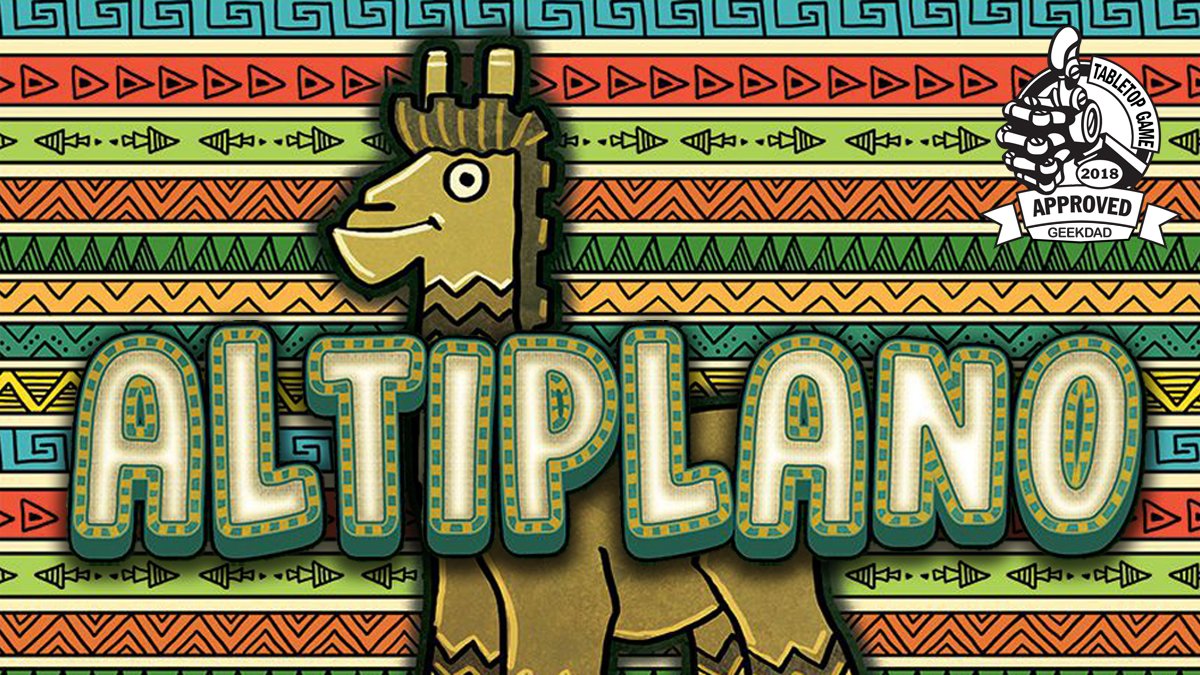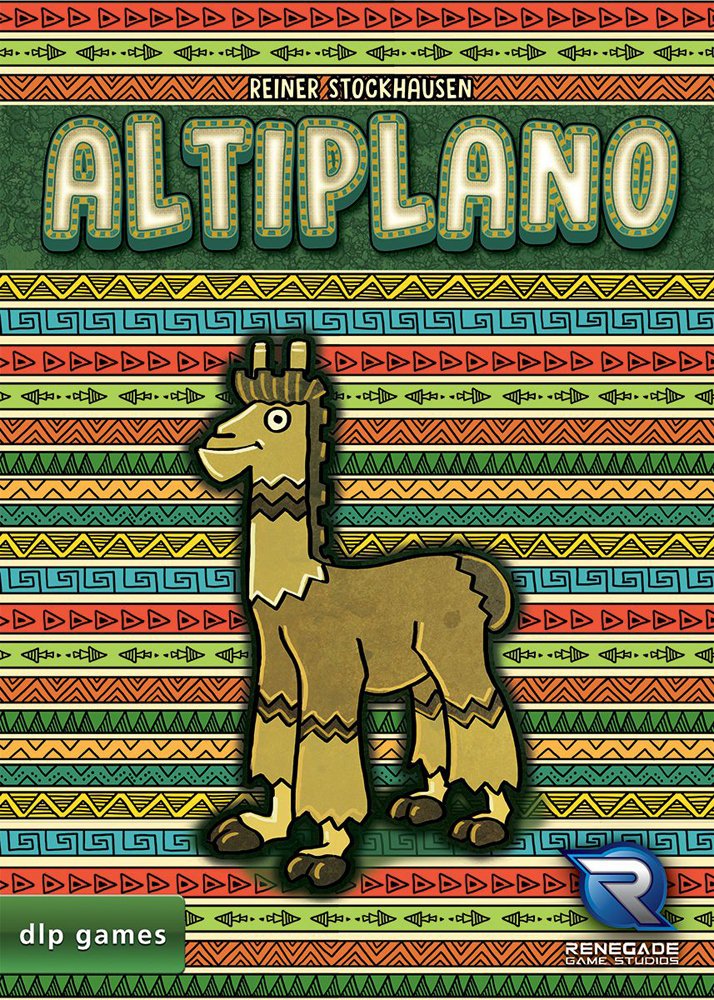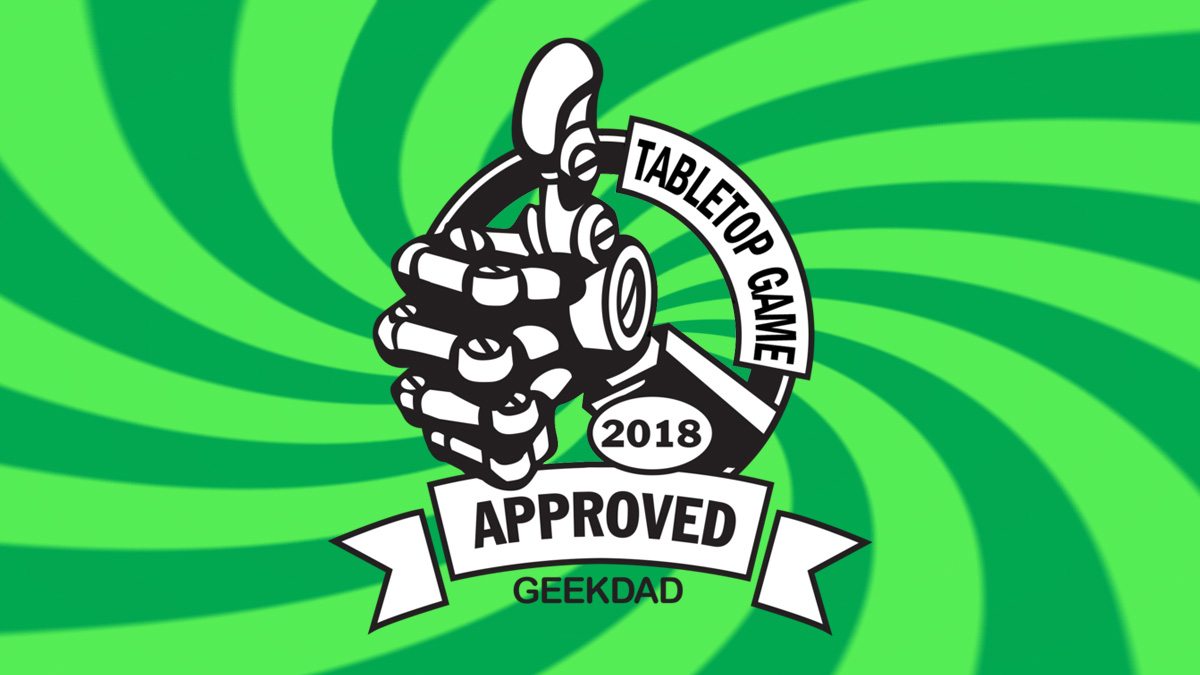Resources are scarce in the South American highlands. Whether you’re a miner, alpaca shepherd, or a stonemason, you’ll need to find ways to trade for the goods you need, and make sure your warehouse is well stocked.
What Is Altiplano?
Altiplano is a “bag-building” game for 2 to 5 players, ages 12 and up, and takes 1–2 hours to play. It was originally published by the German dlp games, and has a North American release today from Renegade Games. The retail price is $65, and it should be available at your local game store, directly from Renegade, or from Amazon. The age rating is primarily for the complexity and length of the game, since there are a lot of rules to keep track of, but there’s nothing inappropriate for younger players. That said, I don’t know if I would go much younger than 10 except with very experienced kids.
A bag-building game is a bit like deck-building, but instead of a deck of cards, you have a bag of things—in this case, tokens representing various resources—which you will draw from. Each player starts with a limited number of tokens, and over the course of the game will add more tokens to their own bag.
Altiplano is GeekDad Approved!
I’m giving Altiplano our GeekDad Approved seal because I think it’s an engaging game and I’ve really enjoyed playing it. My caveat is that it is a slightly heavier game and may be a bit much for younger players or less experienced adults, so read on to find out if it’s for you!
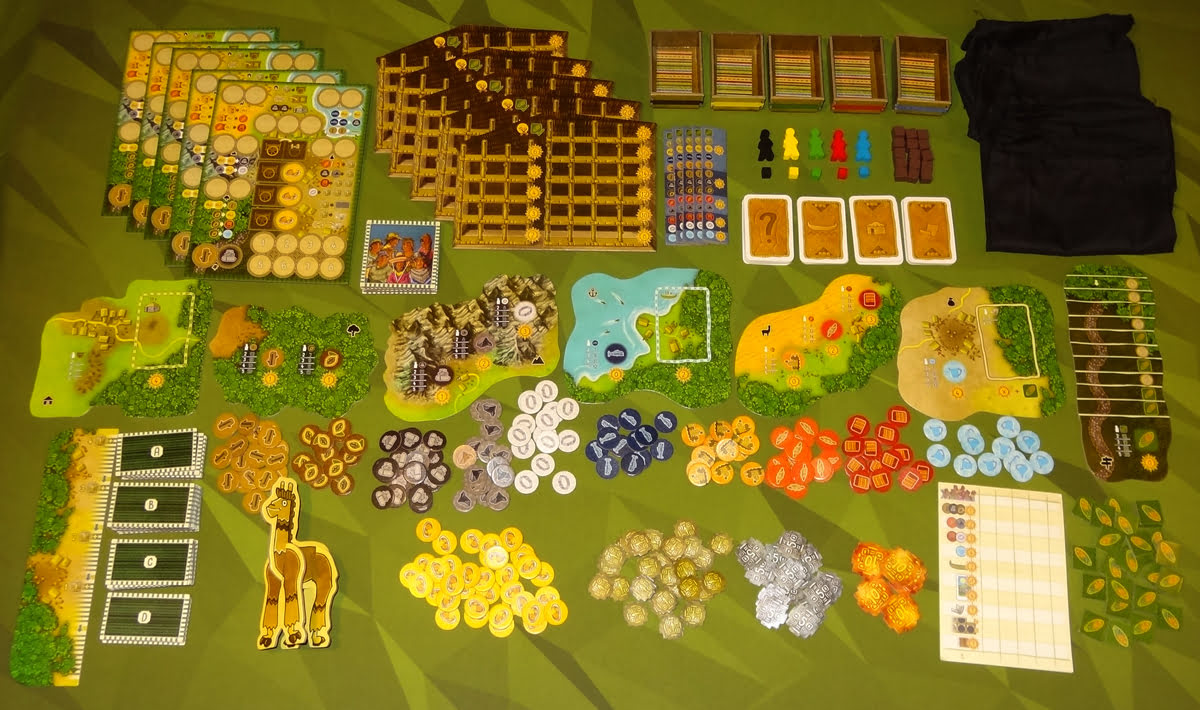
Altiplano Components
Here’s what’s in the box:
- 7 Location tiles (village, market, road, harbor, farm, mine, forest)
- 5 Road markers (1 per player)
- 5 Player pawns
- 5 Containers (1 per player)
- 5 Action boards
- 5 Warehouse boards
- 5 cloth bags
- 5 scoring overview tiles
- 15 carts (brown wooden cubes)
- 10 house cards
- 10 boat cards
- 16 order cards
- 20 mission cards
- 1 scorepad
- 28 Extension tiles
- 1 Extension strip
- 50 Coins (in 1, 5, and 10 denominations)
- 209 goods tiles:
- 36 food
- 25 corn
- 20 wood
- 20 stone
- 15 ore
- 15 cloth
- 15 wool
- 15 silver
- 12 fish
- 12 glass
- 12 alpaca
- 12 cacao
- 7 Role tiles (woodcutter, fisherman, shepherd, miner, farmer, trader, stonemason)
- 1 Start Player marker
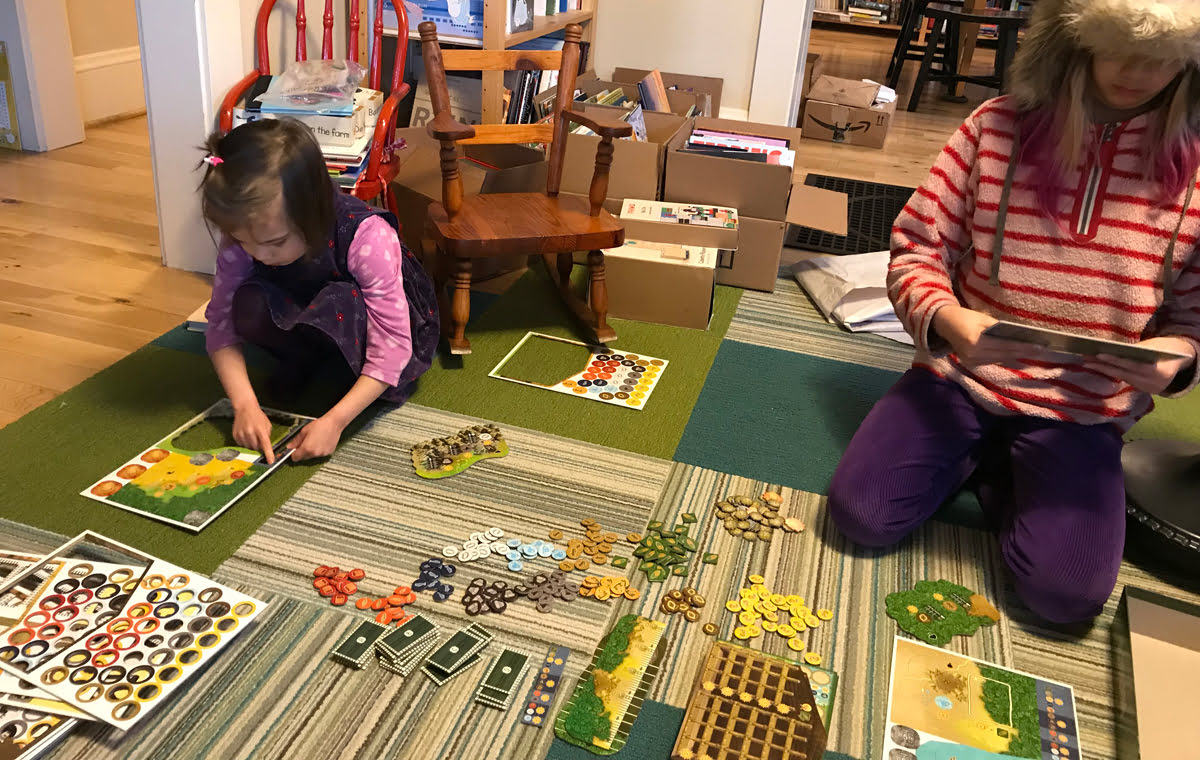
If you love punching out cardboard, you’re already gonna love Altiplano, because there’s a bunch of it: a few larger boards, and a whole bunch of little round tokens. The box doesn’t have any sort of divider, so you’ll have to figure out your own storage solution. Because of the game setup, I decided to bag each of the location tiles with the goods tokens that go with it, and that speeds up setup time.

The components are colorful and fun—the start player marker is a fairly sizable cardboard alpaca that will be passed around during the course of the game. All of the cardboard is sturdy, and the illustrations are stylized and well-done. The various location tiles have irregular shapes, each illustrated to look like the various locations. One nice touch is that each location tile has charts showing how many of each resource to use depending on the player count.
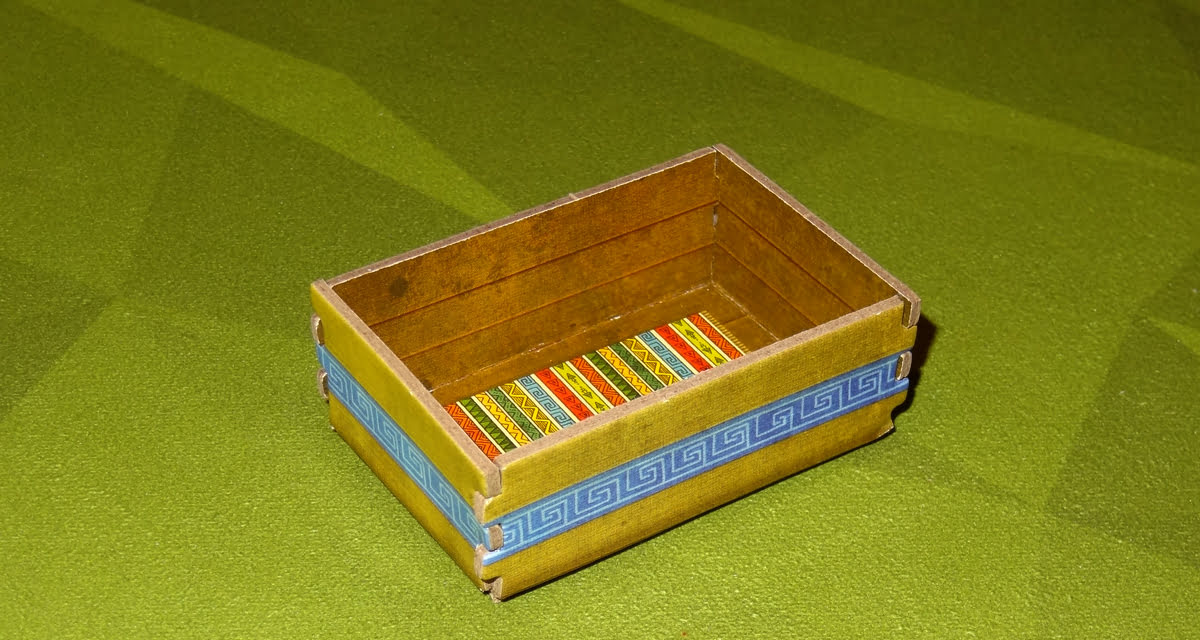
The small cardboard containers serve as the players’ discard piles—they’re a single piece of cardboard, folded and notched together. I added a little bit of glue to hold them together. There’s a stripe along the outside of each box to distinguish the player colors, though you generally won’t get these mixed up at all.
For the most part, the game is color blind friendly because all of the goods tokens have illustrations and aren’t distinguished only by color. The only things that may be problematic are the player pawns and the road tokens, which are small wooden cubes—these are identical except for color, though since each player has one of each, they could easily be substituted if needed.
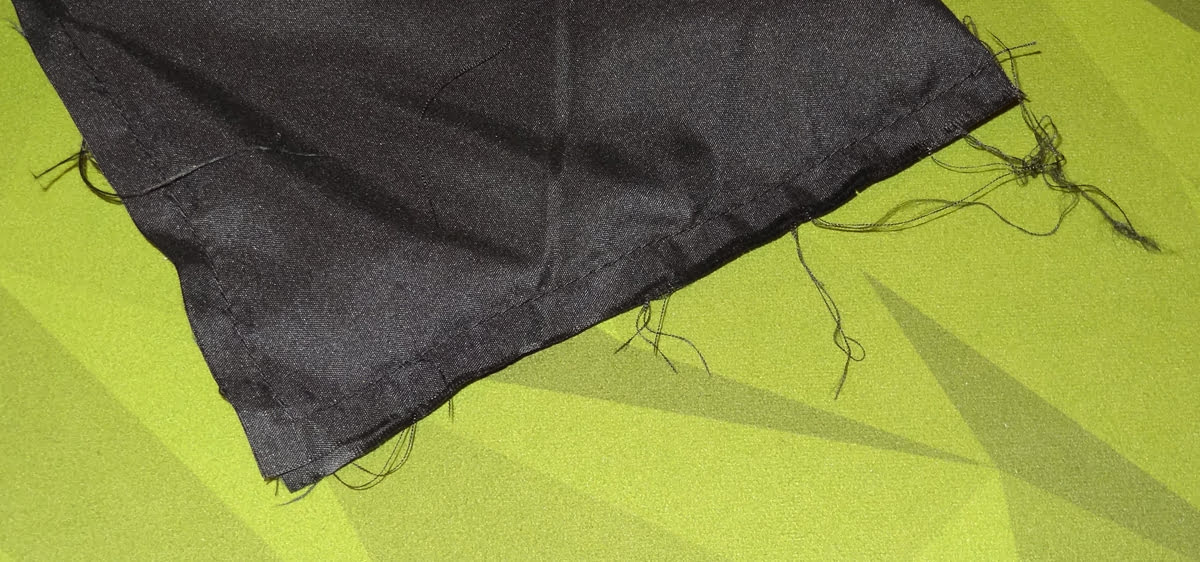
My only big complaint about the components is the cloth bags. They’re made of a thin fabric and have raw edges on the interior of the bag that fray easily, so when you reach into the bag to pull out your goods tokens, you’re likely to pull out a lot of threads with them. I ended up turning the bags inside-out when playing, because then at least I’m not tearing up the bags even more. I’m a little surprised, since many Renegade titles include cloth bags, and they’re usually much higher quality than this. I may consider replacing the bags in my copy if they fray too much.
Overall, though, I’m pleased with the Altiplano components.
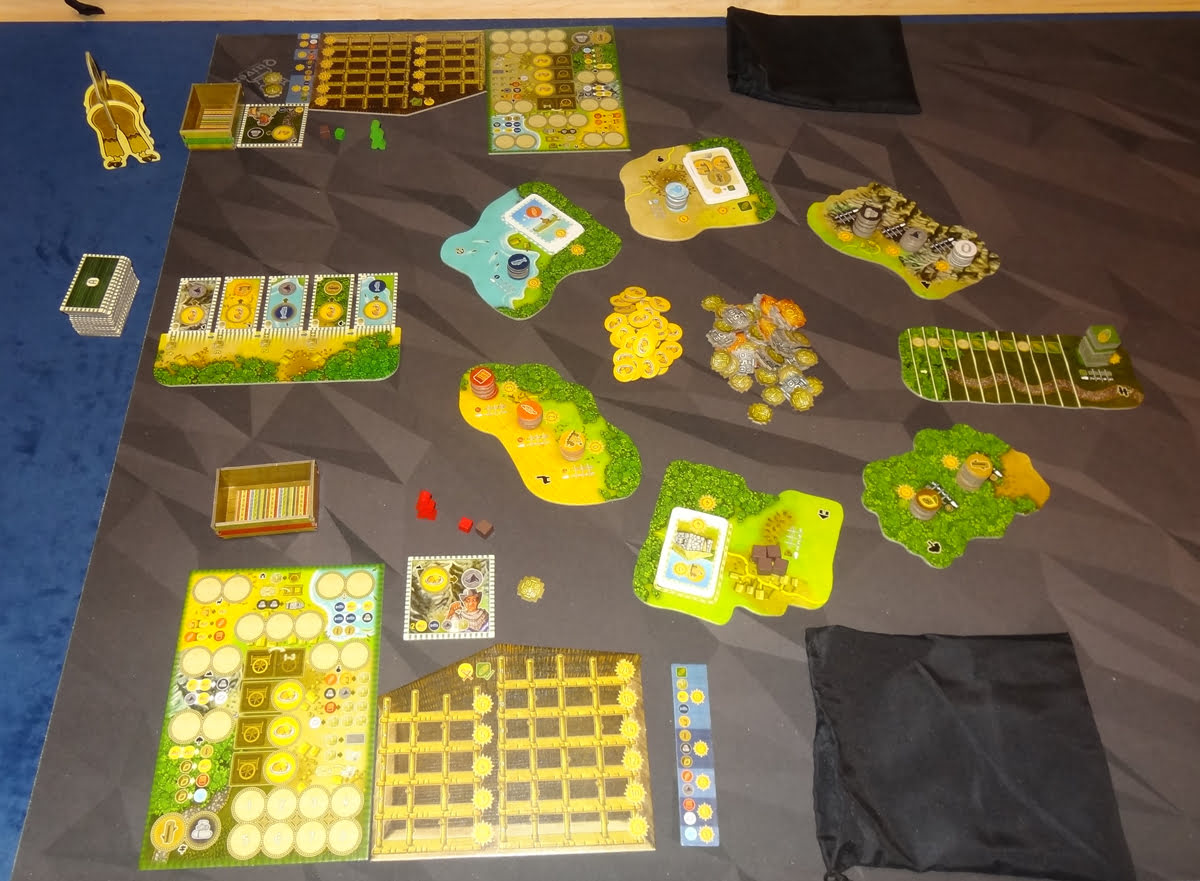
How to Play Altiplano
You can download a copy of the rulebook here.
The Goal
The goal of the game is score the most points by acquiring goods, fulfilling orders, and storing goods in your warehouse.
Setup
Place the location tiles in circle in a random order, forming the plateau. Each location tile holds a number of different goods tokens—the number of each used depends on the number of players, and everything is printed directly on the tiles. Some tiles also hold decks of cards, as indicated.
Put the food tokens and coins in the center of the plateau as a supply.
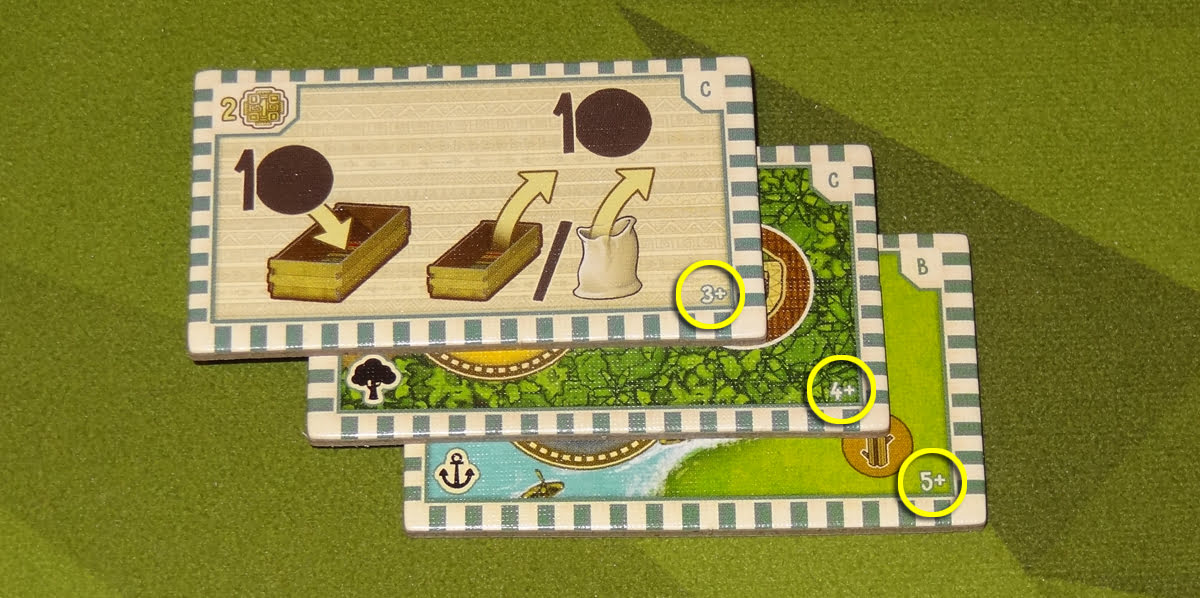
Separate the extension tiles by their backs (A, B, C, D) and shuffle each stack separately. Then combine the stacks so that A is on top. Draw the top five tiles and place them next to the extension strip. Note that some extension tiles will be removed based on the player count.
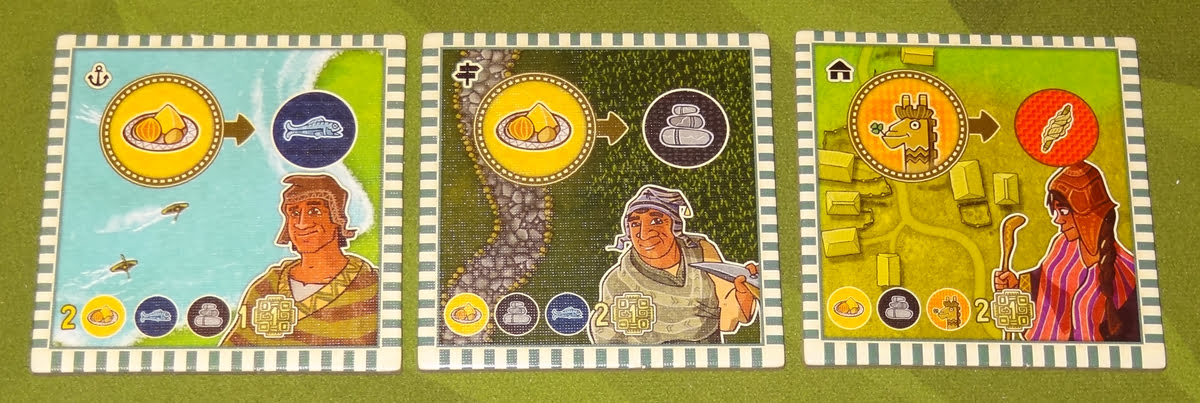
Each player picks a color and takes the container, pawn, and road token of that color. The road token is placed on the highest level of the road location tile (next to the “4”). Each player also takes an action board, a warehouse, a cloth bag, and a randomly selected role tile. Everyone should look at the bottom of their role tile and take the listed starting goods from the plateau, placing them into their bags. (Coins are not placed in the bags, but just kept in a personal supply.) Finally, everyone takes a cart (wooden cube) from the village board and places it on their starting board on the highest cart space of their action board.
Give the start player alpaca to the youngest player.
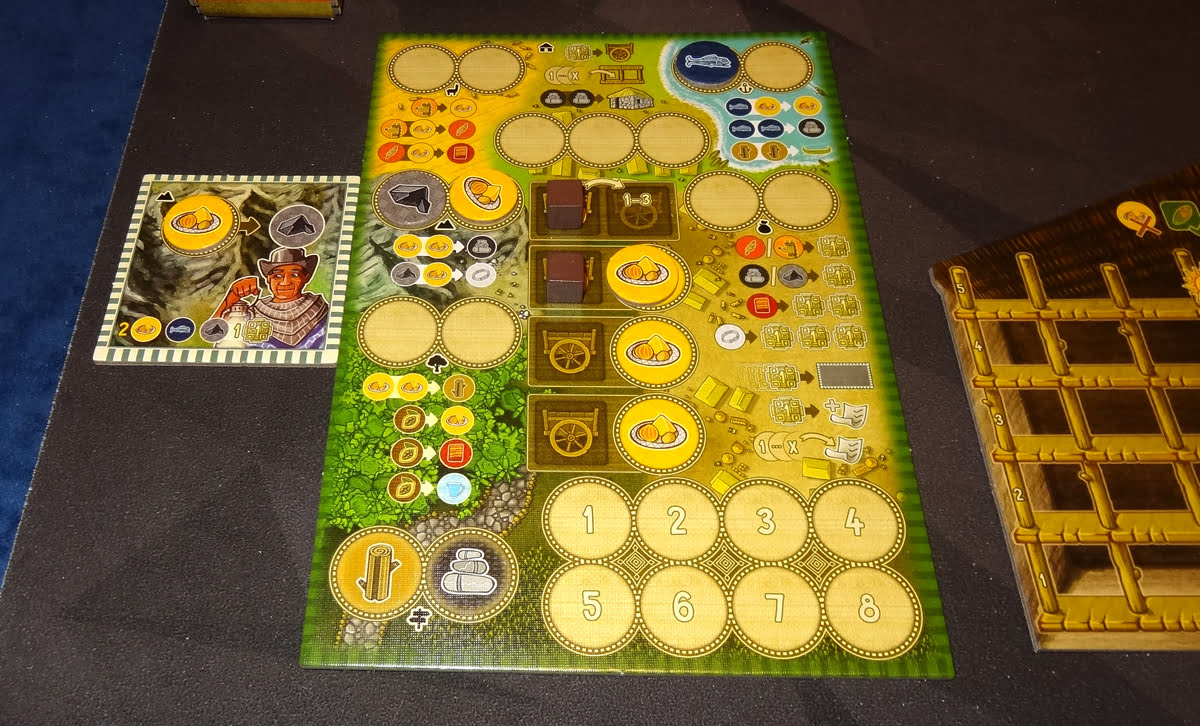
Gameplay
Each round consists of four phases: Drawing, Planning, Actions, and Cleanup.
Drawing
Everyone does the drawing phase simultaneously.
First, if you have any goods tokens on your board that were not spent on a previous turn, you may retrieve them and place them on the numbered planning spaces at the bottom of your action board. Then, you draw tiles from your bag and fill the planning spaces up to the level shown on the road location tile. At the beginning of the game, your road level is 4 so you will draw until you fill spaces 1–4. As you build more roads, you will be able to draw more goods from your bag.
If you don’t have enough tiles in your bag, you dump your container back into your bag, and then draw. If you still don’t have enough tiles to fill your planning spaces, then they remain empty.
Planning
Everyone does the planning phase simultaneously.
You take the tokens from your planning spaces, and place them onto the various action spaces (with dotted circles) on your action board and any extensions you may have. Your role tile also includes an action. Each section of your board has a small icon indicating which location tile the actions apply to, and you are limited to the number of spaces that you have available, one good per space. You may also commit food to the movement spaces (in the center of your action board) for additional movement during the Actions phase. You may leave goods on the planning spaces, but that means you will draw fewer goods next round.
Each location has its own actions available—many of these are using goods to gain new goods, but there are some other special actions as well. Below I’ll show each location tile, along with the associated section of your action board.
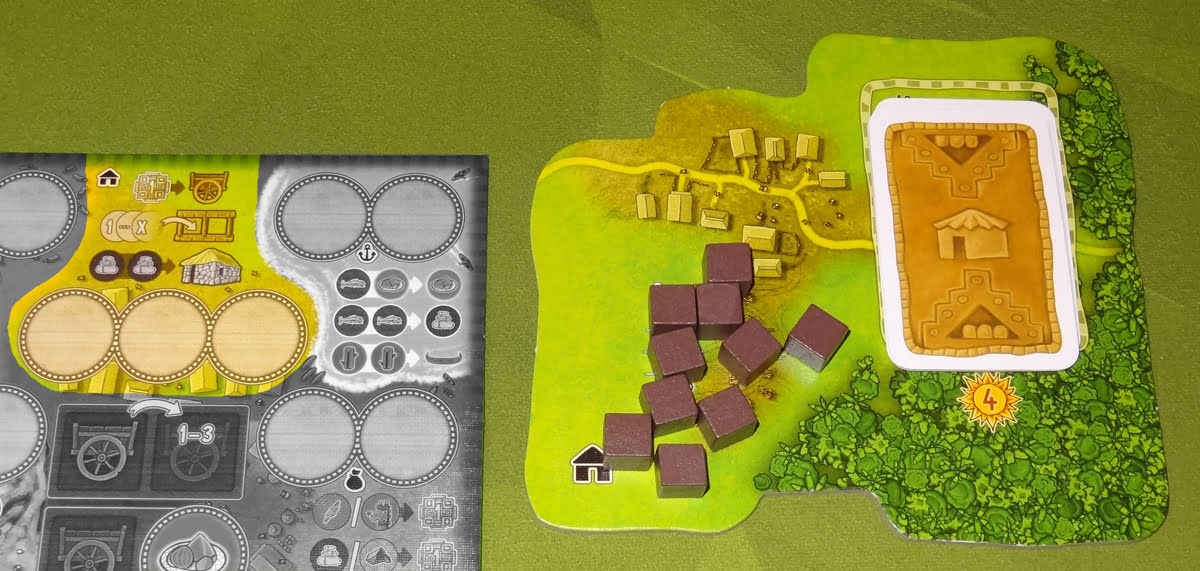
The village has three action spaces, and the rest have two. At the village, you can buy carts (for 1 coin), put goods into your warehouse, and buy house cards for 2 stones.
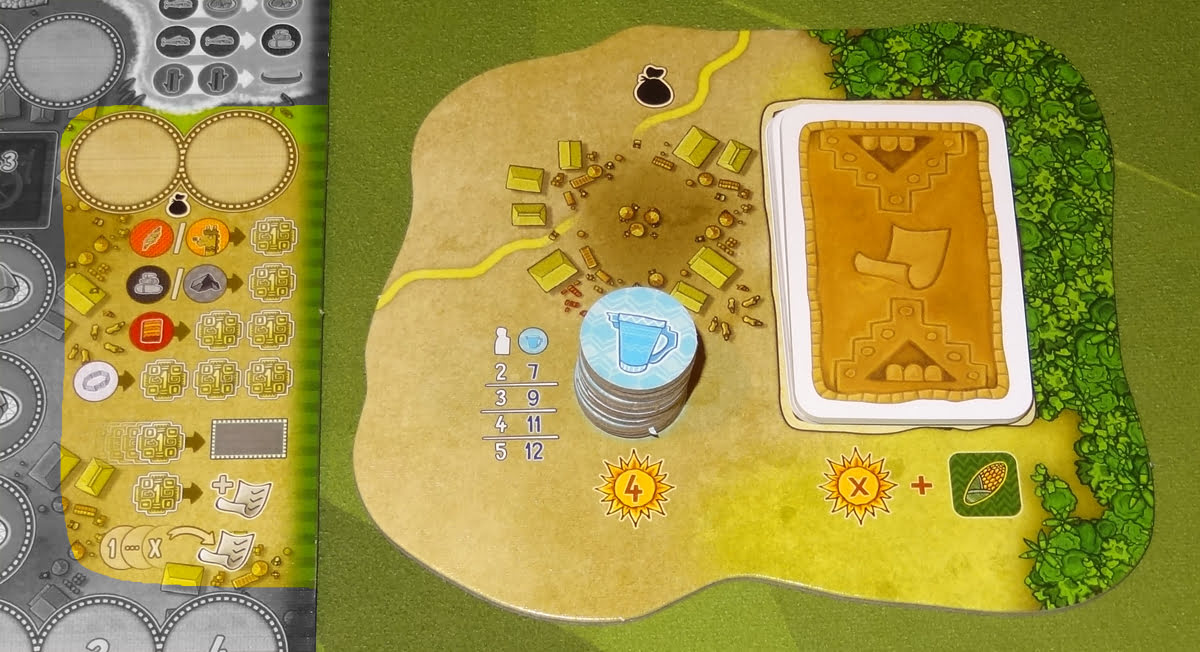
At the market, you can sell goods for coins, and you can also buy extension tiles (more on that later). You can also get order cards and place goods onto order cards. The glass pitchers are stored here, but you don’t have any default actions to get them.

The road only has two spaces, showing a wood and a stone. If you use one of each, you can increase your road level, which will either increase your planning ability or give you 1 corn.

At the harbor, you can get food or stones, and you can also use 2 wood to buy a canoe card.

At the farm, you can get food, wool, or cloth, depending on which resources you spend.
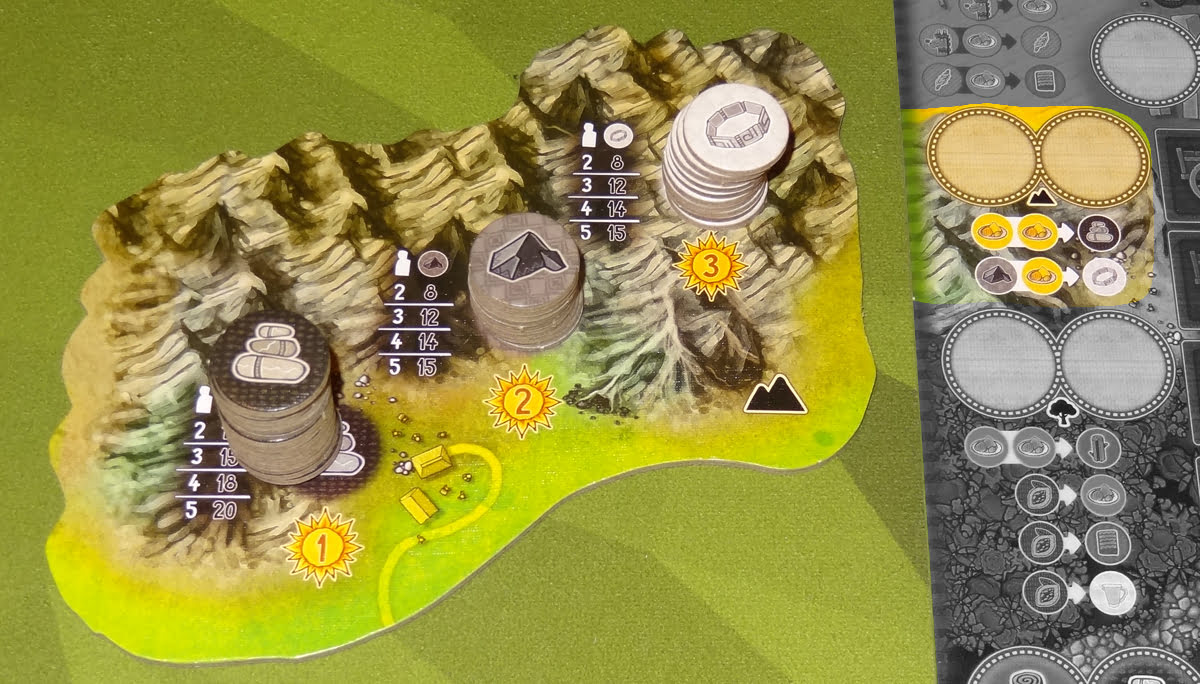
At the mine, you can get stone or silver bracelets. Note that although the ore tokens are stored here, there is no default action to get ore.

At the forest, you can spend 2 food to get 1 wood. You may also trade cacao beans for food, cloth, or glass—but there’s no default action to get cacao beans.
Actions
After everyone is done planning, each player takes their actions, one at a time, in turn order, until everyone has passed.
Before and/or after each action, you may move your pawn. (On your first turn of the game, you may place your pawn onto any location tile.) You have one free movement per round using the cart, which allows you to move up to 3 spaces away, and then you slide the cart to the right to indicate that you’ve used it. The other three movement spaces below that on your action board require 1 food to move to an adjacent tile. If you purchase additional carts for these spaces, each cart will also allow you to move up to 3 spaces, but you must still spend food to move.
You may only take actions if your pawn is at the appropriate location. Then, you spend the goods from your action board to take the action—they go into your container, not back onto the board. Any goods you gain from the action are also placed into your container. Coins that you spend are placed back into the central supply.
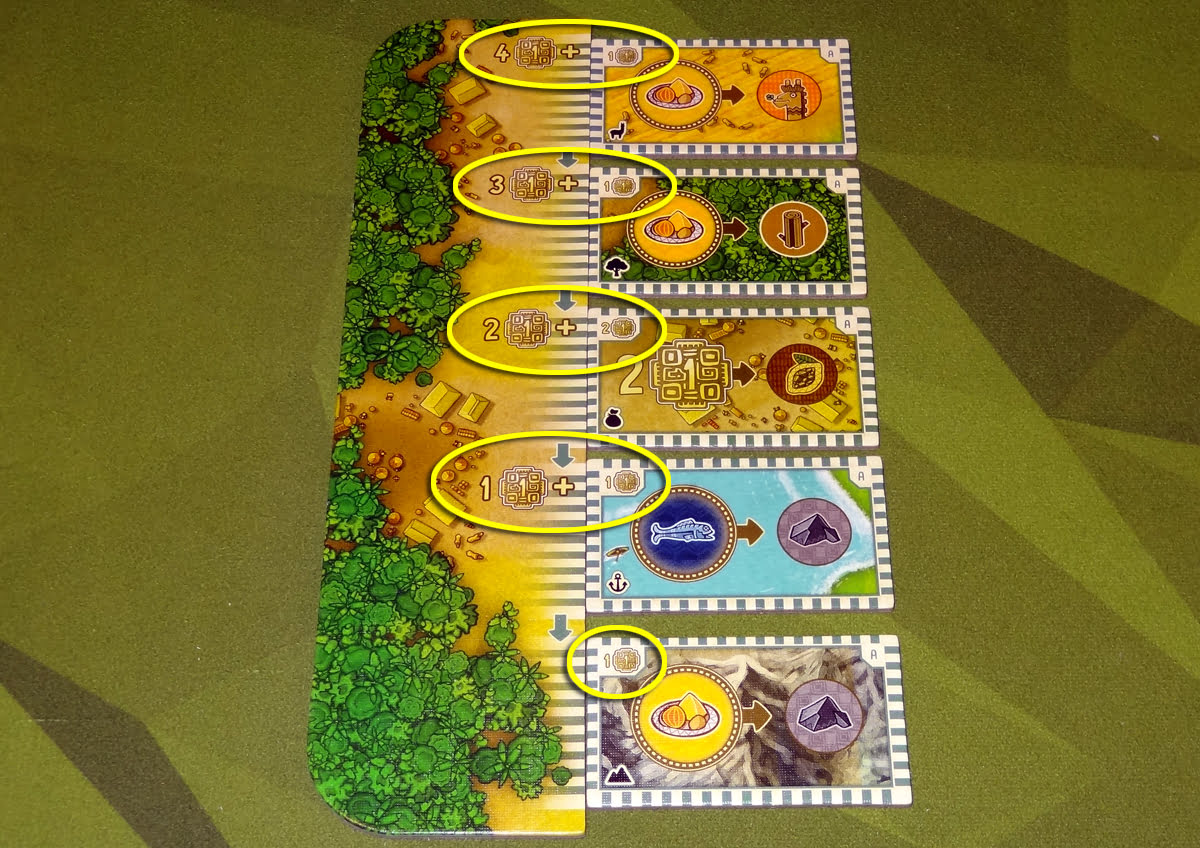
The extension strip has five slots for extension tiles, which provide additional actions. Each extension has a small icon indicating which location it corresponds to. To buy an extension, you must be at the market location, and you pay coins equal to the extension’s base price, plus the cost printed next to it on the extension strip.

At the market, you can also pay 1 coin to take any order card from the deck. You may only have one open order at a time. You also use market action spaces to place goods onto an order card. Once it’s filled, those goods are removed from the game, and you keep the order card for end-game scoring. You also get 1 corn immediately.

At the harbor, you can spend wood to build a boat—take any boat card from the deck, and immediately gain the goods token shown on the card (placing it into your container). Each boat is worth 2 points at the end of the game.
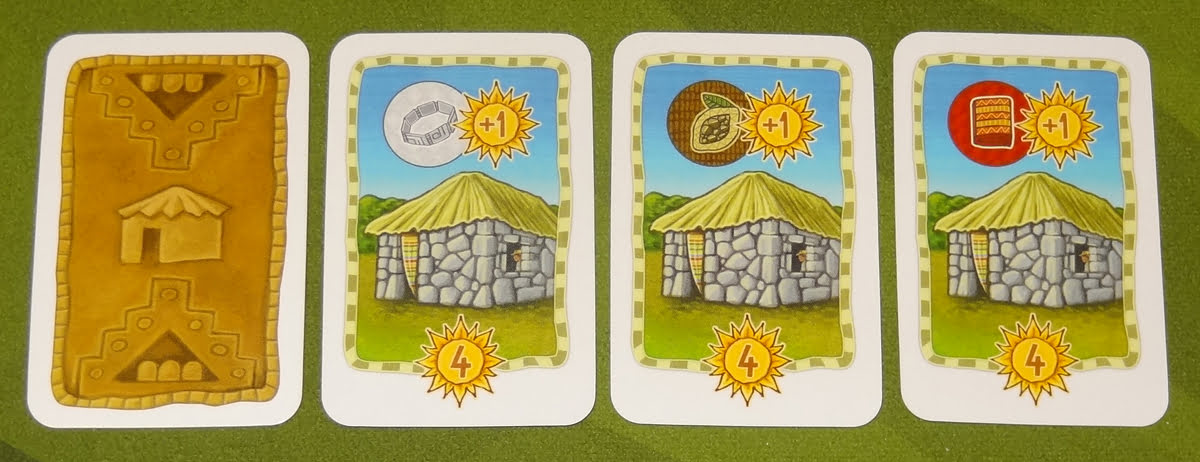
At the village, you may spend 2 stones to build a house, taking any card of your choice from the house deck. Each house is worth 4 points, and also gives you 1 point per token for a specific good.
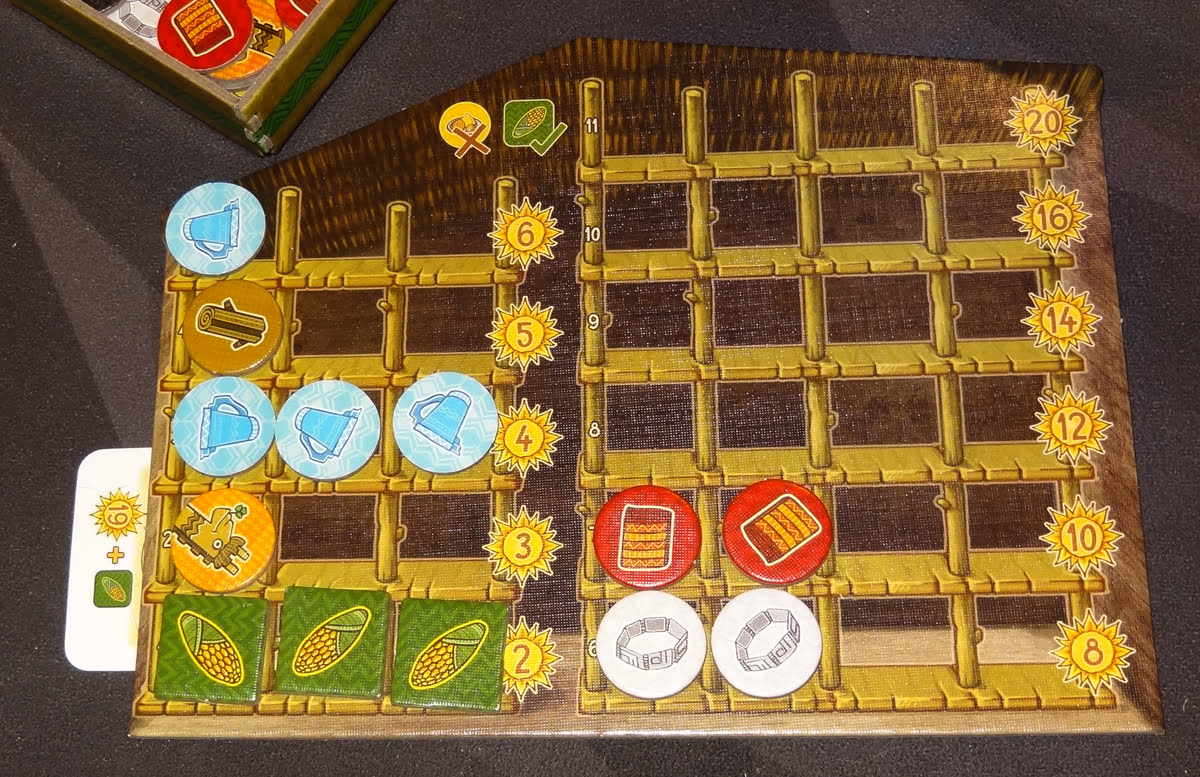
The other action you can take at the village is to store goods into your warehouse. Goods are stored from left to right, starting with the lowest-valued row. Each row in your warehouse can only hold one type of good, and you can’t start a new row of a particular good until you’ve completed the previous row of that good. (For instance, in the photo above, I had to finish the 4-point row of glass before I could put glass in the 6-point row.)
Corn is a special type of good: you can use it as a wild good and place it with any other goods. However, if you start a row with corn, that row must be entirely corn and cannot contain any other goods—and if you have a row that is only corn, that’s the only place you may place corn until the row is completed. Finally, you must store corn as soon as you get it.
You may not store food tokens in the warehouse.
Each completed row in your warehouse will be worth the indicated number of points at the end of the game.
Cleanup
Pass the start player marker clockwise.
Reset the carts: slide all of the carts back to the left column.
Refill extension strip: If no extensions were purchased, discard the one at the bottom. Then, slide all the extensions down, filling in any gaps, and refill from the top.
Game End
The game end is triggered when any of the location boards is totally empty (of goods, cards, and carts), or if there are not enough extensions to refill the extension strip. Finish the current round, and then play one more final round.
Final Scoring
Dump out your bag and container. You will score points for all goods that you have—in your warehouse, on your action board, in your container, and in your bag. You do not count goods that are already on order cards, because those have been traded away and are no longer yours. The point values for goods are shown on the scoring overview tiles, and they’re also printed on the location tiles under the goods icons.
You also score 2 points per boat card, and 4 points per house card, along with the bonus points for the corresponding goods on the houses. You score the listed points on your completed orders, and the points for each completed warehouse row.
The highest score wins, with ties going to the player with the most coins left.

Missions Expansion
There’s also a missions expansion—each player will end up with two secret mission cards, and if you complete your objectives, you will score bonus points. You reveal your mission cards when you complete them. There’s a variety of missions: some require you to collect a certain number of goods, or store particular goods in your warehouse. There are a few that require you to be the first to do something: fulfill an order, build a house, complete a warehouse row with fish.
The setup for the missions involves drafting cards, so you get a little bit of a choice in which missions you take.

Why You Should Play Altiplano
I haven’t played very many bag-building games, but there is at least a little similarity to deck-building games, one of my favorite genres. You start with a basic set of things, and you acquire more over the course of the game, trying to set things up so that you will get certain combinations. There are some fascinating differences, though. In most deck-building games, you start with basic cards and you’re hoping to get some better, stronger cards into your system. In Altiplano, although there is a hierarchy of goods in terms of point value, you aren’t just using your basic goods to get more advanced goods into your bag. You’ll still need basic goods (especially food) throughout the game.
Your action board gives you all sorts of choices, limited by the goods that you managed to pull from your bag, and each round you try to figure out the best way to spend your goods. You always have to account for where your pawn is on the board, because you can only move so many times (and if you don’t have a cart, your movement is even more limited). It can be a logistical puzzle, figuring out not only how to arrange your goods on actions to get what you want, but also how to move to the right locations.
The extension tiles can give you access to all sorts of new actions. For instance: at the start of the game, there are no default actions for acquiring some of the resources, like cacao beans, glass, ore, alpacas, and fish. If you don’t have the role that gives you that good, how do you get it? Well, the extension tiles are one option. Another is to build a boat, which gives you one free resource. Sure, you won’t be able to get more, but if you get one alpaca, you can start making wool to make cloth—just not quite as often as the shepherd.
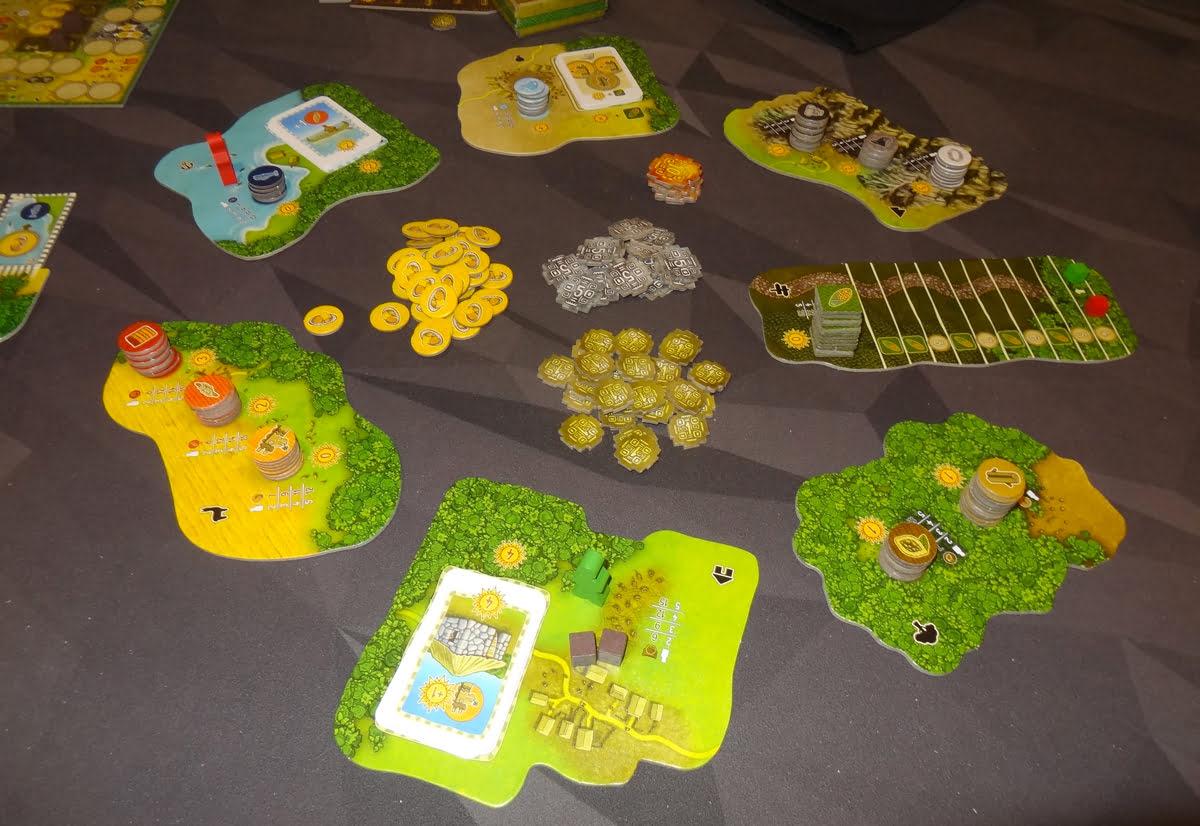
Knowing when to store things in your warehouse is also important: not only are filled rows worth points at the end of the game, but it lets you set aside goods that you don’t want to keep drawing. Glass, for instance, is very valuable, but doesn’t do much of anything else during the game, so each time you draw it, it’s just taking up planning spaces. Storing things gives you some control over what’s left in your bag.
One of the things that really fascinated me about Altiplano is the way that the economy works. The food generally represents work, which is why an alpaca+food=wool, and wool+food=cloth. Each role has a particular strength: the shepherd starts with an alpaca and an action that makes wool without spending the food. The trader is particularly good at earning money. The farmer can raise alpacas—something nobody else can. But it’s generally not enough to just use your one action and nothing else. If you’re the farmer and you raise a bunch of alpacas, you’ll find yourself drawing alpacas all the time—and they’re not even worth points! You need to use them to make wool and cloth, or sell them off on an order card, or build a house that gives you bonus points for having alpacas.
In one game, I started as the miner, so I had easy access to ore, which I then used to make silver bracelets, which are the best way to make money at the market … but money is also not worth anything at the end of the game. The complexity of Altiplano isn’t necessarily in learning how the actions work, but figuring out the chain of actions that’s going to end up with you scoring some points. For some players, building that engine is a really fun challenge; for others, it may feel somewhat dry. I’ll admit that despite the theme, it can still be somewhat abstract, but I really like trying to figure out how to be efficient.
It’s also interesting to play a game in which resources are intended to be scarce. It may not feel that way at first, and you might not run low on everything, but each time I’ve played there have been at least a few resources that are in high demand. When you see one player taking a lot of the same resource, it can also create a panic and cause the other players to scramble for it just to get one before they’re all gone … even if that good isn’t really a good fit for their own engine.
The missions cards are a fun way to give everyone a nudge in a particular direction at the beginning of the game: it can seem a little overwhelming, when you look at your action board and your handful of goods and have to figure out where you’re going to put anything. So having those secret objectives can help you lean toward a particular strategy, and I recommend using them if you don’t feel overloaded with new rules.
The game can take a long time to play, particularly with a five-player game, but I did find that we were able to speed it up a little bit by letting players start their drawing and planning phase soon as they were done with their actions. That way, while the rest of the players were still wrapping up their actions, at least they could start thinking about what they wanted to do next—it saves just a little bit of time each round, and can shorten the total game length a bit.
I’ve really been enjoying Altiplano, and have taught it a few times now. I definitely still need some more practice because I don’t feel like I’m immediately able to figure out what to work on at the beginning of the game, but repeated plays will build familiarity with the actions, particularly knowing the types of actions that will become available on the extensions.
If you like resource-management games and you’ve never tried a bag-building game, it’s worth paying a visit to Altiplano!
Click here to see all our tabletop game reviews.
If you’d like to stay up-to-date with all of our tabletop gaming coverage, please copy this link and add it to your RSS reader.
Disclosure: GeekDad received a copy of this game for review purposes.
